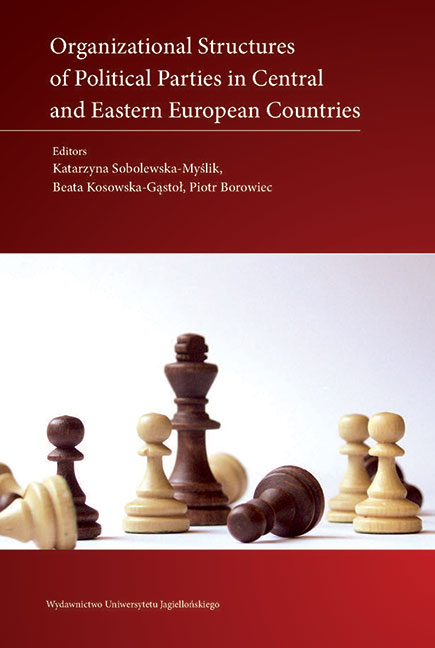Book contents
- Frontmatter
- Contents
- Preface
- Developing Party Structures in Central and Eastern Europe
- Albania: Organizations of Political Parties in Albania
- Belarus: Belarusian Political Parties: Organizational Structures and Practices
- Bosnia and Herzegovina: Organizational Structures of Political Parties in CEE Countries: A Case Study on Bosnia and Herzegovina
- Bulgaria: Organizational Structure and Trends in Bulgarian Party Politics
- Croatia: Organizational Structures of Political Parties in Croatia
- Czech Republic: Between Organizational Extremes: Czech Parties after a Political Earthquake
- Estonia: Organizational Structures of Political Parties in Estonia
- Hungary: Cut from the Same Cloth? A Comparative Analysis of Party Organizations in Hungary
- Kosovo: Structure of the Main Political Parties in Kosovo
- Latvia: Leader-Centered and Power-Hungry: Party Organizations in Latvia
- Lithuania: Organization of Political Parties: The Case of Lithuania
- Moldova: Organizational Structures of Political Parties in The Republic of Moldova
- Montenegro: Party Organization in Montenegro: Structural Resemblance Behind Political Divergence
- Poland: Structures of Polish Political Parties in the Second Decade of the 21st Century
- Romania: The Internal Organization of Romanian Political Parties
- Russia: Parties with Roots Growing Upwards: Organizational Features of Russian Political Parties
- Serbia: Organizational Structures of Political Parties in Serbia
- Slovakia: Organizational Structures of Political Parties in Slovakia: Parties not for Members
- Slovenia: Almost without Any Innovations: Organizational Structures in Slovenian Parties
- Ukraine: Shallow Party Structures in a Volatile Party System
- Comparing Organizational Structures of Political Parties in Central and Eastern European Countries
- Biographical notes about the authors
Latvia: Leader-Centered and Power-Hungry: Party Organizations in Latvia
- Frontmatter
- Contents
- Preface
- Developing Party Structures in Central and Eastern Europe
- Albania: Organizations of Political Parties in Albania
- Belarus: Belarusian Political Parties: Organizational Structures and Practices
- Bosnia and Herzegovina: Organizational Structures of Political Parties in CEE Countries: A Case Study on Bosnia and Herzegovina
- Bulgaria: Organizational Structure and Trends in Bulgarian Party Politics
- Croatia: Organizational Structures of Political Parties in Croatia
- Czech Republic: Between Organizational Extremes: Czech Parties after a Political Earthquake
- Estonia: Organizational Structures of Political Parties in Estonia
- Hungary: Cut from the Same Cloth? A Comparative Analysis of Party Organizations in Hungary
- Kosovo: Structure of the Main Political Parties in Kosovo
- Latvia: Leader-Centered and Power-Hungry: Party Organizations in Latvia
- Lithuania: Organization of Political Parties: The Case of Lithuania
- Moldova: Organizational Structures of Political Parties in The Republic of Moldova
- Montenegro: Party Organization in Montenegro: Structural Resemblance Behind Political Divergence
- Poland: Structures of Polish Political Parties in the Second Decade of the 21st Century
- Romania: The Internal Organization of Romanian Political Parties
- Russia: Parties with Roots Growing Upwards: Organizational Features of Russian Political Parties
- Serbia: Organizational Structures of Political Parties in Serbia
- Slovakia: Organizational Structures of Political Parties in Slovakia: Parties not for Members
- Slovenia: Almost without Any Innovations: Organizational Structures in Slovenian Parties
- Ukraine: Shallow Party Structures in a Volatile Party System
- Comparing Organizational Structures of Political Parties in Central and Eastern European Countries
- Biographical notes about the authors
Summary
Introduction
Political parties have been bourgeoning in post-Communist Latvia as a result of various cleavages (Evans and Whitefiled 1993; Norgard 1999; Ikstens 2005). Moreover, their lifecycle has generally been rather short, and many genuinely new parties have taken over (Sikk 2005). Despite the active genesis of political parties, party membership has remained notably low (van Biezen et al. 2012). This chapter sets out to explore how these small parties operate, and what organizational patterns they develop in response to the generally competitive circumstances in Latvia. The analysis is based on a survey of political parties represented in the Latvian parliament, Saeima, as a consequence of the 2014 general elections: Harmony, Unity, Union of Greens and Farmers, the National Alliance; the Regional Alliance of Latvia, and From Heart to Latvia.
Legal Framework
Latvia freed itself from Soviet occupation in August of 1991 as a result of a failed coup d’état in Moscow. While the actual advent of independence turned out to be sudden, it was preceded by a period of intensive and coordinated efforts to regain independence starting in the late 1980s both within, as well as outside, the Soviet Union. In view of the non-recognition policy of Latvia's occupation pursued by several dozens of countries across the globe, Latvia based its struggle for regaining independence on the principle of legal continuity of the Republic of Latvia (Blūzma et al. 1998). It was this principle that largely conditioned the restoration of the 1922 constitution after the collapse of the Soviet Union in August of 1991.
The original constitution of Latvia was expected to have two major parts: one outlining the major institutional elements of the country's governance; and the second enlisting the rights and obligations of citizens. The first made no reference to political organizations; the second was never adopted in the 1920s and 1930s due to political rifts (Pleps 2008).
Work to consummate the constitution resumed after 1991, and the second part of the basic law enshrining human rights was adopted in 1998. Political parties were referred to exclusively in the context of freedom of assembly, and were not afforded special status (such as that granted to parties in the 1949 German Grundgesetz).
- Type
- Chapter
- Information
- Organizational Structures of Political Parties in Central and Eastern European Countries , pp. 231 - 250Publisher: Jagiellonian University PressPrint publication year: 2017



